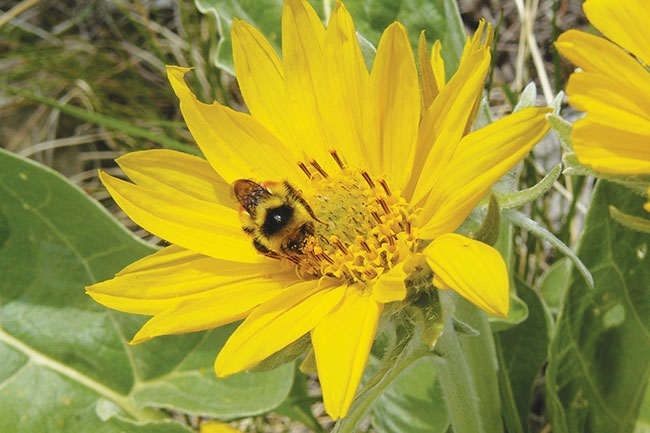
News
DriftWatch helps locate bees and sensitive crops
In Saskatchewan, specialty crop producers with honeybees, organics, orchards and other sensitive crops have a new communication strategy to help address risks and provide special protection from nearby pesticide applications and potential spray drift. This collaborative program, DriftWatch Saskatchewan, is improving communication between producers and pesticide applicators.
“We began our discussion of a DriftWatch type program in 2012, after a season of higher than normal insecticide related bee incidents,” explains Geoff Wilson, provincial specialist, apiculture, with the Saskatchewan Ministry of Agriculture, at Prince Albert. “After some initial discussions with Bayer CropScience, we identified the concept of better communication between beekeepers and applicators as a good place to begin risk mitigation. We looked at potential implementation options including developing our own program. In our search we came across DriftWatch as an interesting alternative.”
DriftWatch was developed by Purdue University in Indiana and is now run by a non-profit organization. This system is free to use for both the producer with sensitive areas and the pesticide applicator. Current membership in DriftWatch includes 12 U.S. states, primarily in the Midwest, while Saskatchewan is the first province to adopt such a communication tool in Canada. DriftWatch Saskatchewan allows producers to highlight areas needing special protection from pesticide drift so that pesticide applicators know these locations before making application decisions.
“Very early on, we brought together key stakeholders, including the Saskatchewan Beekeepers Association, the Saskatchewan Aerial Applicators Association and other government staff, to develop a collaborative approach to implementation,” says Wilson. “Bayer CropScience and Dow AgroSciences were part of the collaboration from the beginning, and provided funding support to make the membership and software available to Saskatchewan producers and applicators for the pilot project.”
DriftWatch Saskatchewan, a two-year pilot project, was launched in 2014 for the production season. Under this voluntary program, producers with honeybees, organics, orchards and other specialty crops can register online. To register and upload their land location, producers go to www.DriftWatch.com, register as a user, fill out some characteristics of the location (i.e. honeybees, organics, etc.) and draw their location on the online map. DriftWatch is a risk mitigation tool that improves communication about the best options to reduce the risk of pesticide damage, but is not a guarantee that there will be no future pesticide incidents.
“We have data stewards for the various specialty crops and areas of concern to make sure the proper information is uploaded and only those eligible are using the program,” explains Wilson. “This system is intended for agricultural producers and not homeowners or people on sites of less than half an acre. I am the data steward for the bees, and other specialists are stewards for fruit production, organics and other special crops areas.”
Once the information is uploaded, then aerial applicators can access the map interface and additional tools and use this information in their application plans. It improves communication and allows applicators to talk to beekeepers to manage sensitive areas, change their plans if the wind is in the wrong direction or implement other strategies to reduce the risk of spray drift. The system is dynamic, and producers can go in anytime and update their information as they move beehives around or change crops, for example.
The uptake in the first year of the pilot project has been very good. For the 2014 DriftWatch program, Saskatchewan had the third highest number of apiaries registered of all 13 registered members. “We are pleased with the results of the first year and in particular the excellent collaboration between all of the stakeholders,” says Wilson. “Part of the collaboration was bringing the stakeholders together early on and making sure the program is what the beekeepers and special crop producers need and the same with the aerial applicators. The feedback so far in the first year has generally been very positive, although the late spring and general season conditions meant we ended up with fewer applications this year.”
The Saskatchewan DriftWatch pilot project will continue in 2015, and at the end of the season stakeholders will evaluate the it and make the next decisions. “The collaborative approach has been one of the best aspects for me, and the efforts of the stakeholders to work together to address the concerns,” says Wilson. “The collaboration continues in various ways including my invitation to speak at the Aerial Applicators Association in November (2014), and the Aerial Applicators Association has been invited to the upcoming beekeepers convention. It is wonderful that they are continuing the conversation and working together to address these issues. DriftWatch shows a lot of promise for Saskatchewan stewardship efforts.”
February 18, 2015 By Donna Fleury
 The DriftWatch program is improving communication between producers and pesticide applicators in Saskatchewan. Improving communication between beekeepers and pesticide applicators.
The DriftWatch program is improving communication between producers and pesticide applicators in Saskatchewan. Improving communication between beekeepers and pesticide applicators.